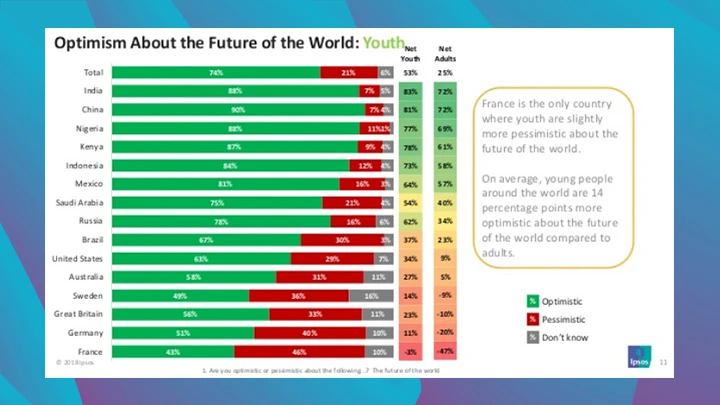Young people in lower- and middle-income countries may lack the comfort or material wealth that kids in more economically stable places have, but they’re–impressively–currently leading in a different metric: positivity that progress is possible.
Overall, 79% of people between the ages of 12 and 24 in Brazil, China, India, Indonesia, Kenya, Mexico, Nigeria, and Russia say they feel optimistic about the direction of the world, compared to only about half of those in far more well-off places like Australia, France, Germany, Great Britain, and Sweden. In the United States, the number is 63%.

But economic improvement has an obvious psychological effect on the people it reaches. To show that, the Gates Foundation commissioned the Global Youth Poll, a survey of more than 40,000 respondents of all ages internationally. That effort was run by Ipsos, an independent market research company, and showed another powerful result: People in lower- and middle-income countries are more likely than those in higher-income spots to support the idea that their generation can have more impact on the world than their parents did. It’s 63% to 39% respectively.

The question now is how can that optimism be harnessed to keep creating positive change. In lower- and middle-income countries, the top quality of life issues deal with securing better educational opportunities, continued reductions in poverty, and creating more accessible good jobs for everyone.
Part of that may happen through political involvement. In India, Kenya, and Nigeria, for instance, more than two-thirds of young folks believe that they can help influence how their countries are governed. (In the U.S., less than half of all young people agree with that statement.) It may also happen through a rising professional class: It’s very common for folks in improving places to report wanting to become doctors, engineers, and teachers. (For comparison, the U.S. also ranks the best job as doctor–although that’s followed closely by gamer.)
The report data shows that the governments, companies, and individual philanthropists in higher-income countries in particular should probably do more, too. Over half of both younger and older populations in Australia, Great Britain, and the U.S. were unaware of the sustainable development goals. And the U.S. government, at least, continues to score low in its overall commitment to sustainable development and has backed away from global commitments to counter climate change. In a way, this poll may help shift that perspective and awareness. It’s hard to push others toward continued progress if you don’t understand why it’s so important.
Recognize your brand’s excellence by applying to this year’s Brands That Matter Awards before the early-rate deadline, May 3.
